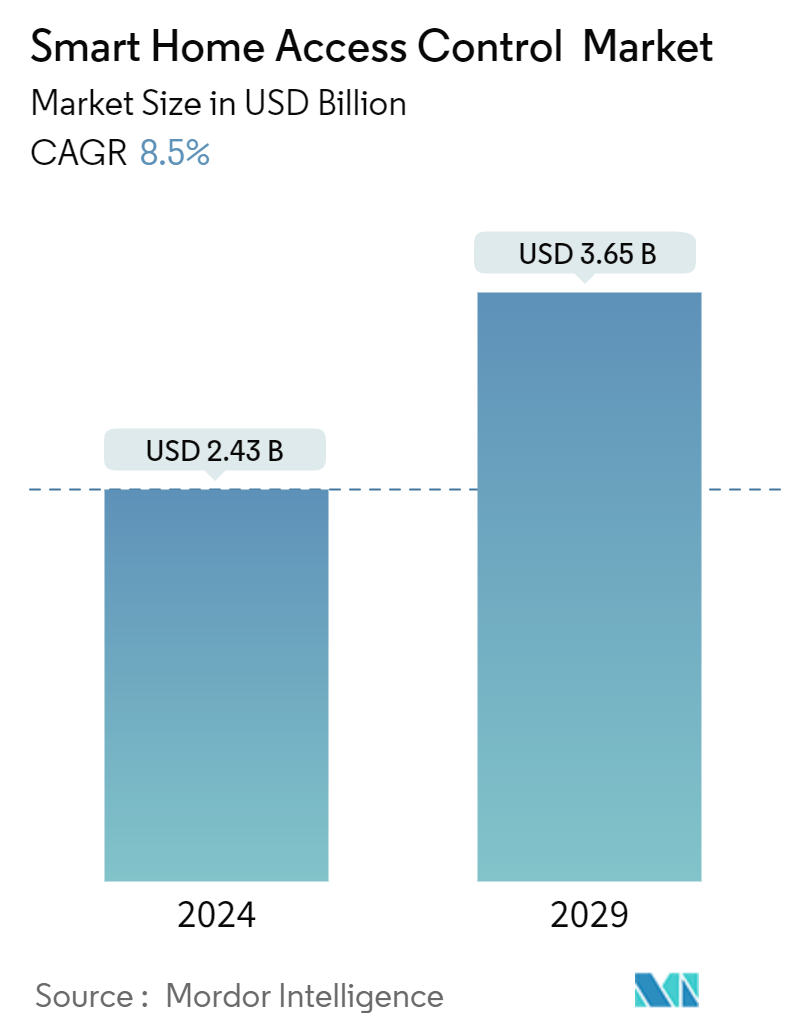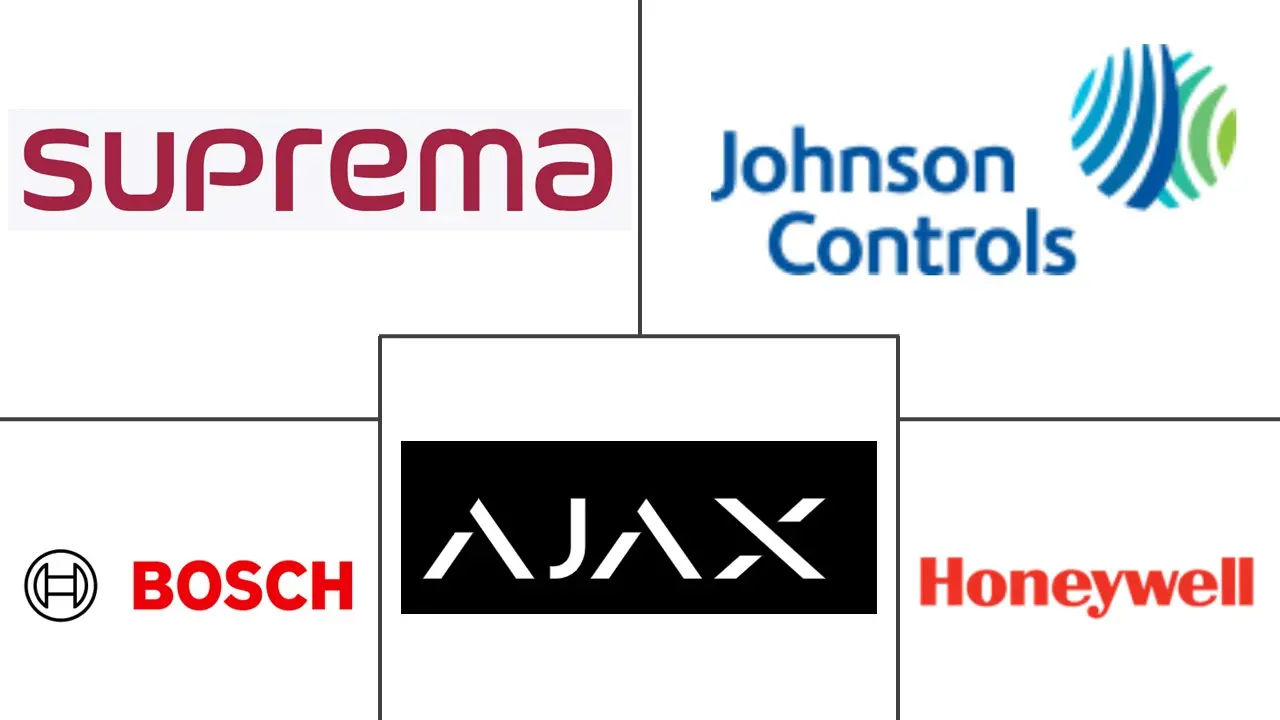Market Size of Smart Home Access Control Industry

| Study Period | 2019 - 2029 |
| Market Size (2024) | USD 2.43 Billion |
| Market Size (2029) | USD 3.65 Billion |
| CAGR (2024 - 2029) | 8.50 % |
| Fastest Growing Market | Asia Pacific |
| Largest Market | North America |
Major Players
*Disclaimer: Major Players sorted in no particular order |
Smart Home Access Control Market Analysis
The Smart Home Access Control Market size is estimated at USD 2.43 billion in 2024, and is expected to reach USD 3.65 billion by 2029, growing at a CAGR of 8.5% during the forecast period (2024-2029).
While heavy steel doors and blaring alarms are often the focus of home security discussions, smart access control presents a more nuanced yet potent security solution. Utilizing entry codes, key fobs, and access cards, smart access control governs entries. Its key strength lies in its capacity to secure spaces and impact factors ranging from insurance coverage to mitigating accident losses.
Several factors are fueling the growth of the smart home access control market. These include heightened safety concerns due to rising burglary rates and the prevalence of nuclear families, especially in scenarios involving working parents and separated elderly relatives.
For homeowners, smart access control is pivotal in ensuring the privacy and security they deserve. Whether for communal areas, car parks, or personal flats, implementing barriers against unauthorized access enhances a property's appeal and provides valuable insights into building entries.
Moreover, the surge in tech-savvy populations and the rise of home automation projects bolstered the demand in the market.
While modern access control systems leverage cutting-edge technologies like biometrics, RF, Bluetooth, and NFC, end users are sometimes deterred by the associated testing, training, and implementation costs. Additionally, a lack of public awareness and operational hesitations, especially concerning the benefits of cloud-integrated wireless locks, pose hurdles to market expansion.
The global pandemic has significantly altered the landscape of smart home access control systems, emphasizing the monitoring of occupancy data to ensure safety. With both existing technologies and new additions introduced under the post-pandemic recovery agenda, the market is poised to unveil fresh opportunities in the future.
Smart Home Access Control Industry Segmentation
A smart home access control system is an intelligent system that involves new technologies such as electronics, communication technology, and computer technology. It is a measure to solve security issues and manage entry and exit points. Moreover, it ensures resources within the home can be accessed only by authorized users, even restricts legitimate users, and prevents unauthorized users.
The smart home access control market is segmented by type (card reader and access control devices [card-based, proximity, and smart card (contact and contactless)], biometric readers, electronic locks, software, and other types) and geography (North America [United States and Canada], Europe [United Kingdom, Germany, France, and Rest of Europe], Asia-Pacific [China, India, Japan, South Korea, and Rest of Asia-Pacific], and Rest of the World). The market sizes and forecasts are provided in terms of value (USD) for all the segments.
| By Type | |||||
| |||||
| Biometric Readers | |||||
| Electronic Locks | |||||
| Software | |||||
| Other Types |
| By Geography*** | ||||||
| ||||||
| ||||||
| ||||||
| Australia and New Zealand | ||||||
| Latin America | ||||||
| Middle East and Africa |
Smart Home Access Control Market Size Summary
The smart home access control market is experiencing significant growth, driven by increasing safety concerns and the rise of tech-savvy consumers. This market offers advanced security solutions that go beyond traditional methods, utilizing technologies such as biometrics, RF, Bluetooth, and NFC to enhance property security. The demand for smart access control systems is fueled by the need for privacy and security in residential areas, communal spaces, and parking facilities. Despite the benefits, challenges such as high implementation costs and limited public awareness about cloud-integrated wireless locks hinder market expansion. The COVID-19 pandemic has further transformed the market, highlighting the importance of occupancy monitoring and creating new opportunities for innovation and growth.
Asia is emerging as a key player in the smart home access control market, with rapid adoption of technological advancements and increased consumer spending power. The region's growth is supported by widespread smartphone use, government initiatives in digital transformation, and the rollout of 5G technology. These factors, combined with the expansion of the middle class, are driving demand for advanced security solutions. Additionally, government investments in smart city projects, such as Toyota's 'Woven City,' are expected to create new opportunities for market players. The competitive landscape is characterized by both global and regional players, with companies like Suprema Inc., Johnson Controls, and Honeywell International Inc. making strategic moves to enhance their market presence.
Smart Home Access Control Market Size - Table of Contents
-
1. MARKET INSIGHTS
-
1.1 Market Overview
-
1.2 Industry Attractiveness - Porter's Five Forces Analysis
-
1.2.1 Bargaining Power of Suppliers
-
1.2.2 Bargaining Power of Consumers
-
1.2.3 Threat of New Entrants
-
1.2.4 Threat of Substitute Products
-
1.2.5 Intensity of Competitive Rivalry
-
-
1.3 Industry Value Chain Analysis
-
1.4 Impact of Macro Economic Trends on the Market
-
-
2. MARKET SEGMENTATION
-
2.1 By Type
-
2.1.1 Card Reader and Access Control Devices
-
2.1.1.1 Card-based
-
2.1.1.2 Proximity
-
2.1.1.3 Smart Card (Contact and Contactless)
-
-
2.1.2 Biometric Readers
-
2.1.3 Electronic Locks
-
2.1.4 Software
-
2.1.5 Other Types
-
-
2.2 By Geography***
-
2.2.1 North America
-
2.2.1.1 United States
-
2.2.1.2 Canada
-
-
2.2.2 Europe
-
2.2.2.1 United Kingdom
-
2.2.2.2 Germany
-
2.2.2.3 France
-
-
2.2.3 Asia
-
2.2.3.1 China
-
2.2.3.2 Japan
-
2.2.3.3 India
-
2.2.3.4 South Korea
-
-
2.2.4 Australia and New Zealand
-
2.2.5 Latin America
-
2.2.6 Middle East and Africa
-
-
Smart Home Access Control Market Size FAQs
How big is the Smart Home Access Control Market?
The Smart Home Access Control Market size is expected to reach USD 2.43 billion in 2024 and grow at a CAGR of 8.5% to reach USD 3.65 billion by 2029.
What is the current Smart Home Access Control Market size?
In 2024, the Smart Home Access Control Market size is expected to reach USD 2.43 billion.

